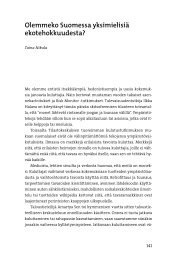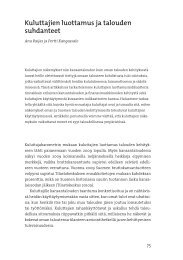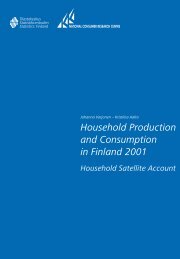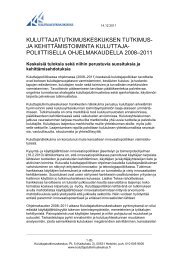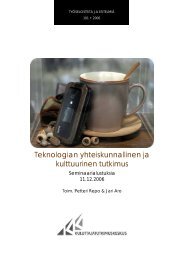Household Production and Consumption in Finland 2001
Household Production and Consumption in Finland 2001
Household Production and Consumption in Finland 2001
You also want an ePaper? Increase the reach of your titles
YUMPU automatically turns print PDFs into web optimized ePapers that Google loves.
<strong>in</strong>fluences the efficiency of labour <strong>in</strong>put (e.g. Rob<strong>in</strong>son 1982, Ruuskanen<br />
2004). For example, <strong>in</strong> a survey on the leisure time use, most respondents<br />
(61%) felt that cook<strong>in</strong>g was “at least sometimes a pleasure <strong>and</strong> a hobby”, <strong>and</strong><br />
the same was true for garden<strong>in</strong>g. In the same survey, about one-half of the<br />
respondents said they regarded do<strong>in</strong>g the laundry <strong>and</strong> clean<strong>in</strong>g “always as a<br />
rout<strong>in</strong>e <strong>and</strong> a duty”. On the other h<strong>and</strong> more than one-quarter said they never<br />
helped with the laundry <strong>and</strong> one <strong>in</strong> ten said they never did any clean<strong>in</strong>g up<br />
(Hanifi 2005, 128).<br />
The <strong>in</strong>ternational literature on satellite accounts works from the<br />
assumption that as far as household production is concerned, it is irrelevant<br />
whether people enjoy the work they are do<strong>in</strong>g or whether they consider it<br />
simply a chore <strong>and</strong> a duty (e.g. Goldschmidt-Clermont 1994). After all the<br />
same goes for wage employment: it is very rarely that people are paid on the<br />
basis of whether or not they enjoy the job they are do<strong>in</strong>g. Prepar<strong>in</strong>g a meal at<br />
home therefore has economic significance regardless of the cook’s mood, <strong>and</strong> a<br />
well-tended garden <strong>in</strong>creases the value of hous<strong>in</strong>g services even if people did<br />
their garden<strong>in</strong>g simply because they enjoyed it (see also Chapter 4.3). It is also<br />
noteworthy that the data collected for the Time Use Survey is so extensive<br />
that it probably <strong>in</strong>cludes people who take very different views on this matter<br />
<strong>and</strong> that these fluctuations will be smoothed away <strong>in</strong> averages.<br />
The value of labour is calculated by multiply<strong>in</strong>g the amount of time spent <strong>in</strong><br />
unpaid work by the hourly wage of a person <strong>in</strong> an equivalent paid job. For this<br />
study we opted to use the hourly pay of generalist housekeeper/ home helper,<br />
which <strong>in</strong> the International St<strong>and</strong>ard Classification of Occupations (ISCO)<br />
comes under category 51331. Earlier studies <strong>in</strong> F<strong>in</strong>l<strong>and</strong> have also used this<br />
same wage to determ<strong>in</strong>e the value of unpaid work (Säntti et al. 1982,<br />
Vihava<strong>in</strong>en 1995). Accord<strong>in</strong>g to <strong>2001</strong> wage statistics, the gross hourly wage of<br />
a housekeeper <strong>and</strong> home helper, exclud<strong>in</strong>g employer’s social <strong>in</strong>surance<br />
contributions, was 9.99 euros/hour.<br />
There has been much debate <strong>in</strong> the <strong>in</strong>ternational literature on the choice of<br />
the most appropriate wage concept that would be compatible with national<br />
account<strong>in</strong>g pr<strong>in</strong>ciples (see e.g. Blades 1997, Varjonen et al. 1999). Should we<br />
use net wages or gross wages, or perhaps gross wages with employer<br />
contributions. Here a case <strong>in</strong> po<strong>in</strong>t has been the wage concept used <strong>in</strong><br />
calculat<strong>in</strong>g outputs <strong>in</strong> the public sector <strong>and</strong> <strong>in</strong> non-profit <strong>in</strong>stitutions serv<strong>in</strong>g<br />
households. These calculations use gross wages <strong>in</strong>clud<strong>in</strong>g all employer<br />
contributions.<br />
Analogously, then, we might use the same wage concept to determ<strong>in</strong>e the<br />
value of household production. It has also been suggested that different wage<br />
concepts might be used depend<strong>in</strong>g on the end-use of the results. If the purpose<br />
is to describe the expenditure <strong>in</strong>curred to a household from purchas<strong>in</strong>g a<br />
service from the market <strong>in</strong>stead of produc<strong>in</strong>g that service itself, then the most<br />
appropriate choice is gross wage plus employer costs because all these costs are<br />
<strong>in</strong>cluded <strong>in</strong> the price of the product. If, on the other h<strong>and</strong>, the purpose is to<br />
describe changes <strong>in</strong> the household’s disposable <strong>in</strong>come when it produces a<br />
service <strong>in</strong>stead of buy<strong>in</strong>g that service, net wage might be a more appropriate<br />
choice: this is because <strong>in</strong> this activity the household does not generate social<br />
security, nor does it add to public sector tax revenue.<br />
National Consumer Research Centre Statistics F<strong>in</strong>l<strong>and</strong> 19




